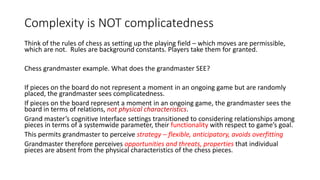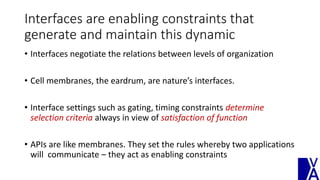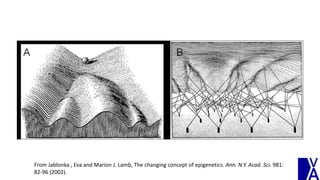Complexity is not complicatedness
- 1. Complexity is Not Complication Deliberate Complexity July 19, 2022 Alicia Juarrero, PhD Department of Philosophy, University of Miami (FL) President and Co-Founder, VectorAnalytica, inc. www.vectoranalytica.com [email protected]
- 2. Complicatedness/complication • Disordered and randomly entangled parts, or • Linear cause-effect relations among large numbers of elements and processes • These produce additive effects • Additive effects can be difficult in fact (but possible in principle) to track and predict. • In complicated systems: • There are no mutual dependencies – elements do not change in virtue of being constituents of a coherent totality • No phase transition means no qualitatively novel properties
- 3. Complicated Complex • Linear. Output is smoothly proportional to input. • Properties of the whole are additive. • Sand dune = sum of the sand grains • Nonlinear. Output is discontinuous with input. • Complex systems emerge as a result of discontinuous phase transitions • Properties of the whole are qualitatively different (relational) synchrony • Ex: Ecosystems, Organizational culture
- 4. Constraints are not “Causes” • Efficient causes (from Aristotle) – are energetic transfers. • Ex: forceful impacts of cue stick hitting cue balls; hammering nails into wood. • Efficient causes alone do not generate complexity • Constraints: are conditions or factors that raise or lower barriers to energy, matter, and information flow --without themselves directly transferring energy • Ex: the organism’s vasculature does not impart energy directly: it channels and organizes energy flow. Timing kick on a playground swing (does not transmit more energy than the kick itself). • Catalysts and feedback
- 5. Context-dependent constraints enable complexity • Some constraints (catalysts and feedback) link separate and independent elements and processes such that they become conditional on one another. They become inherently context-dependent. • I call this type of context-dependent constraints enabling constraints – they facilitate the weaving together of interdependencies (among parts, and between parts and context) – ex: synchrony, entrainment, alignment • Enabling constraints self-organize interdependent, coherent, coordination dynamics = new coherent dynamics = novel information Result: Complex systems are embedded (not just plunked) in a context (temporal as well as spatial).
- 6. MEREOLOGY = interlevel relations • Mereology -- Parts-to-whole and whole-to-parts relations • Enabling constraints generate novel interdependencies organized as heterarchies (W.S. McCullough 1945) • Interdependencies are qualitatively different from their components (severally or added) – “more is different” (P.W. Anderson 1972). • Interdependencies are new “types of phenomena,” integrated totalities with emergent properties
- 8. A B C D
- 9. A C D
- 10. Mechanical vs effective input • Mechanical input to complicated systems: • 2x forceful cause 2x effect; linear relation between input and output • Effective input to complex systems: • Same input can produce qualitatively different output. Different inputs can integrate into same output
- 11. Living things do this routinely • Internal and external signals (nutrients, environmental temperature, fatigue) are selected, integrated, processed and reacted to in terms of their role in achieving/maintaining the overarching system’s dynamic equilibrium) – given historical and current context • Relational interactional (emergent) properties become the variables that matter: Ex: inflammation)
- 13. CLOSURE OF CONSTRAINTS From Montevil & Mossio 2015
- 14. Interdependencies have novel properties • Emergent properties are relational properties that keep those interdependencies together – • Relational properties function as constitutive/governing constraints • Governing constraints exercise control top-down, from wholes to parts
- 16. Key differences between complexity and complication • Complexity originates in context-dependent enabling constraints that generate complex interdependencies • Individual processes in complex systems change the likelihood of their occurring conditional upon the interdependencies in which they are embedded • Complex interdependencies themselves become constitutive/governing constraints” that maintain/preserve the coherence.
- 17. Complexity is NOT complicatedness Think of the rules of chess as setting up the playing field – which moves are permissible, which are not. Rules are background constants. Players take them for granted. Chess grandmaster example. What does the grandmaster SEE? If pieces on the board do not represent a moment in an ongoing game but are randomly placed, the grandmaster sees complicatedness. If pieces on the board represent a moment in an ongoing game, the grandmaster sees the board in terms of relations, not physical characteristics. Grand master’s cognitive Interface settings transitioned to considering relationships among pieces in terms of a systemwide parameter, their functionality with respect to game’s goal. This permits grandmaster to perceive strategy – flexible, anticipatory, avoids overfitting Grandmaster therefore perceives opportunities and threats, properties that individual pieces are absent from the physical characteristics of the chess pieces.
- 18. Interfaces are enabling constraints that generate and maintain this dynamic • Interfaces negotiate the relations between levels of organization • Cell membranes, the eardrum, are nature’s interfaces. • Interface settings such as gating, timing constraints determine selection criteria always in view of satisfaction of function • APIs are like membranes. They set the rules whereby two applications will communicate – they act as enabling constraints
- 19. How to manage complex systems? • By adjusting enabling and governing constraints, relations, interdependencies, and context in general (internal and external, historical and environmental, cultural, psychological) • Prairie grasses and chaparral (Allen & Starr). • Expanding adaptive space anticipatorily – the gating rules of the interface between prairie ecosystem and its original environment (horses were alien predators under the original dynamics) widens (coarsens?) to become more generic and thereby increase its capacity to handle unforeseen novelty • That the chess grandmaster does; perceiving the world in terms of constrained relations allows you to zoom out and reveals systemwide parameters (strategy, opportunities, threats) vis a vis goals
- 20. From Jablonka , Eva and Marion J. Lamb, The changing concept of epigenetics. Ann. N.Y. Acad. Sci. 981: 82-96 (2002).
Editor's Notes
- #3: I tend to use terms “parts” and “constituents” for complicated systems; “components” for complex systems Density of grains of sand in a sand dune does not change the properties of the grains of sand. This is because interactions do not generate a phase change that qualitatively alters the properties or dynamics of parts in complicated systems.
- #4: Ex: SYNCHRONY CAN COLLAPSE A BRIDGE OR THE STADIUM STANDS emerge from integration of component parts. Ex: Synchronized, oscillatory behavior is not just the sum of the individual components WHAT TURNS INDIVIDUAL ELEMENTS AND PROCESSES INTO COMPLEX SYSTEMS? CONSTRAINTS
- #6: So what is it about interactions that generate complexity? They are constrained Interactions that create new information by generating coherent interdependencies Circularity of iteration/recursion/feedback loops Newtonian science considers space and time containers… things move within absolute space and time but are not inherently changed by them.
- #7: Mereology– bete noir because of assumptions of efficient causation – enabling constraints are not energetic “causes” Feedback – circular causality. Import environment/export dynamics creates totality with properties qualitatively different from the properties of the components separately. Ex: Ecosystems and cultures are examples of these emergent totalities Top-down causality is emergent property of coherent dynamics
- #8: Self-reinforcing – nonlinear – Self-sustaining -- Whole process generates emergent properties (metabolism, endocrinological stability, neuromuscular dynamics, perception) –
- #10: EX: METABOLISM, PERCEPTION Emergent properties are multiply realizable metastable dynamics. Different paths can generate the same emergent property (conversely: same paths under different circumstances can result in different emergent properties)
- #11: Hierarchical (heterarchical) organization has emerged
- #12: That is, signals are admitted and processed bottom up with reference to overarching systemic properties, in that context, at that moment. Those systemic properties become the “parameters that matter” to the system Once integrated and processed, the interdependencies modulate/regulate systemic behavior with reference to what’s previously happened to/in that living thing (ontogenetically and phylogenetically) – because living things are path-dependent complex systems. This explains PTSD, allergies, effects of Dutch winter. If organisms or social systems processed signals solely in terms of the signal’s physical characteristics, emergent properties of interdpendnecies would be missed Homeostasis is a novel, systemwide property. No individual component exhibits homeostasis. Only the organism in context does.
- #13: HYPERCYCLES – HOMEOSTASIS, metastable dynamics incorporating metabolism, inflammation, endocrinology, neuroskeleton,…. PROPRIOCEPTION – sixth sense of where your body is in space – the twisties CULTURE – combines social, psychological, economical, historical, geographical, religious…
- #14: Circular causality (feedback, autocatalysis; parts arranged into loops) generate hypercycles (Eigen 1971) ALSO ORGANIZED HIERARCHICALLY – in levels of organization
- #15: HOMEOSTASIS, PROPRIOCEPTIOIN Ex: Synchrony, entrainment, alignment. Why can it modulate/regulate components? Because overarching system has several paths to realization (degeneracy; multiple realizability) Soldiers march in cadence/breaking step Lasers cauterize Congestion shock waves
- #17: Interfaces and boundaries need not be physical – they can be rate separations (ex: tornadoes and hurricanes) These include buffering, damping, entrenchment, rules and regulations, platform “settings”. by regulating internal and external environments with a view towards achieving and preserving functional dynamic balance
- #18: When you’re dealing with a human/tech system HOW DOES THIS HAPPEN?
- #20: Interfaces establish communication in terms of the “variables that matter” to the system They filter, recode, re-format, and select “effective input” from sundry analog signals impinging on a system such that metabolism can function Bottom-up and top-down relations are implemented through “multiple constraint satisfaction” – with reference to past, to internal and external conditions, and
- #21: Note term manage, not predict and control
- #22: LAST SLIDE FOR THIS PRESENTATION
- #23: METAPHOR: Sturdy, stable structure will get me results (to the other shore) Switch from paddles to oars and oarlocks, sliding seats -- Ignores background context (lake placidity)
- #24: TRANSITION FROM LAMINAR TO TURBULENT FLOW IN PHYSICS– through mid 20thcentury “The last unsolved problem in classical physics” --- non-equilibrium processes exhibiting cascades Newton knew about the three-body problem Science and philosophy choose to ignore context (third body)
- #25: Design framework must include context in tool design























